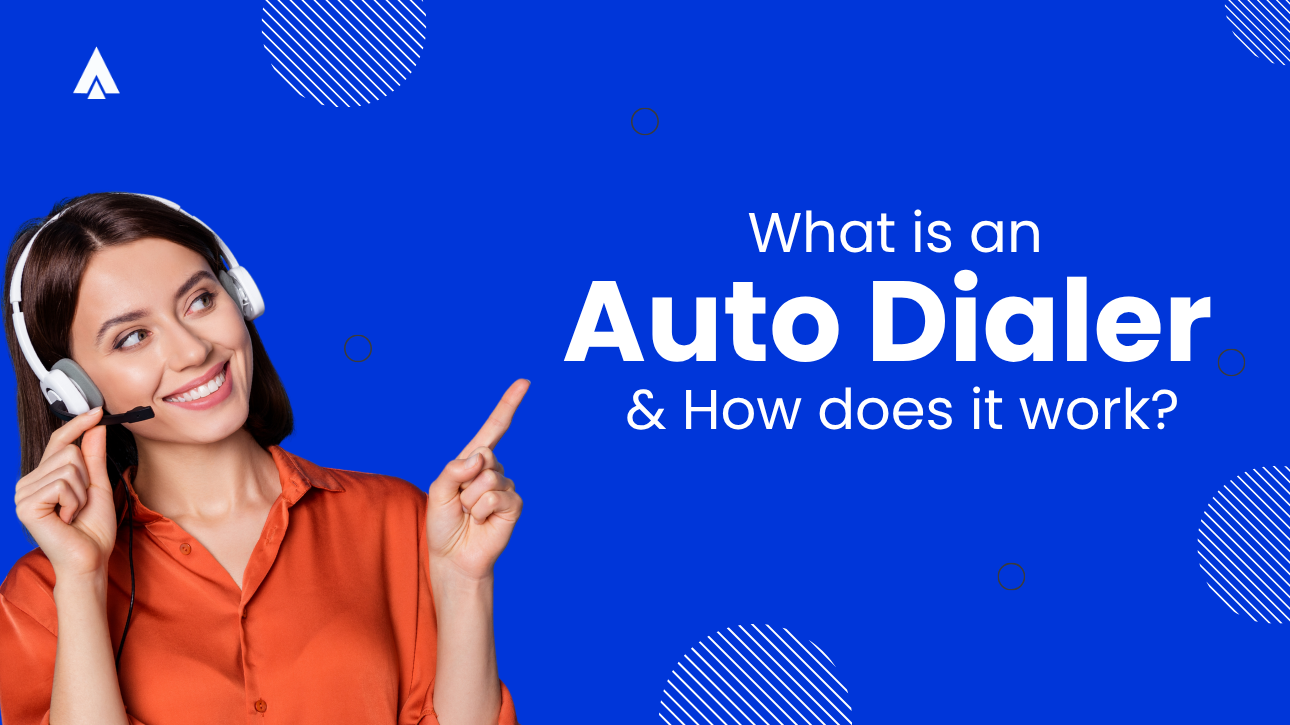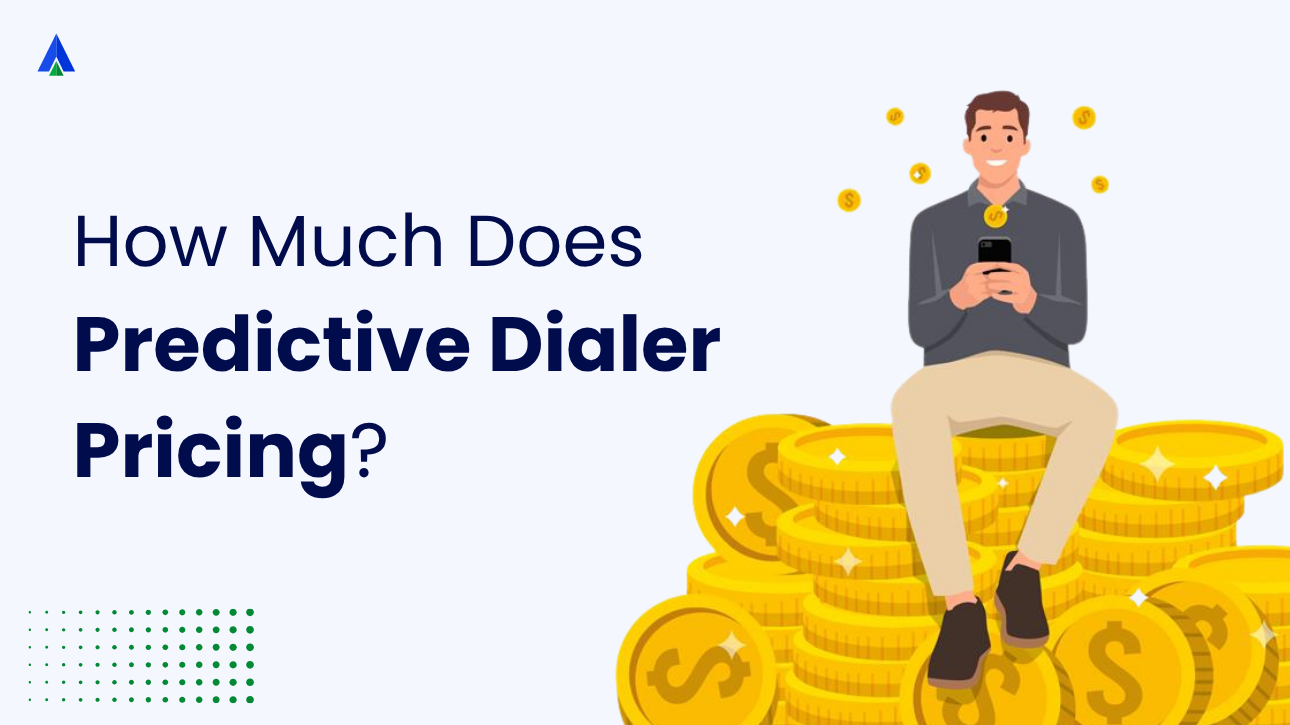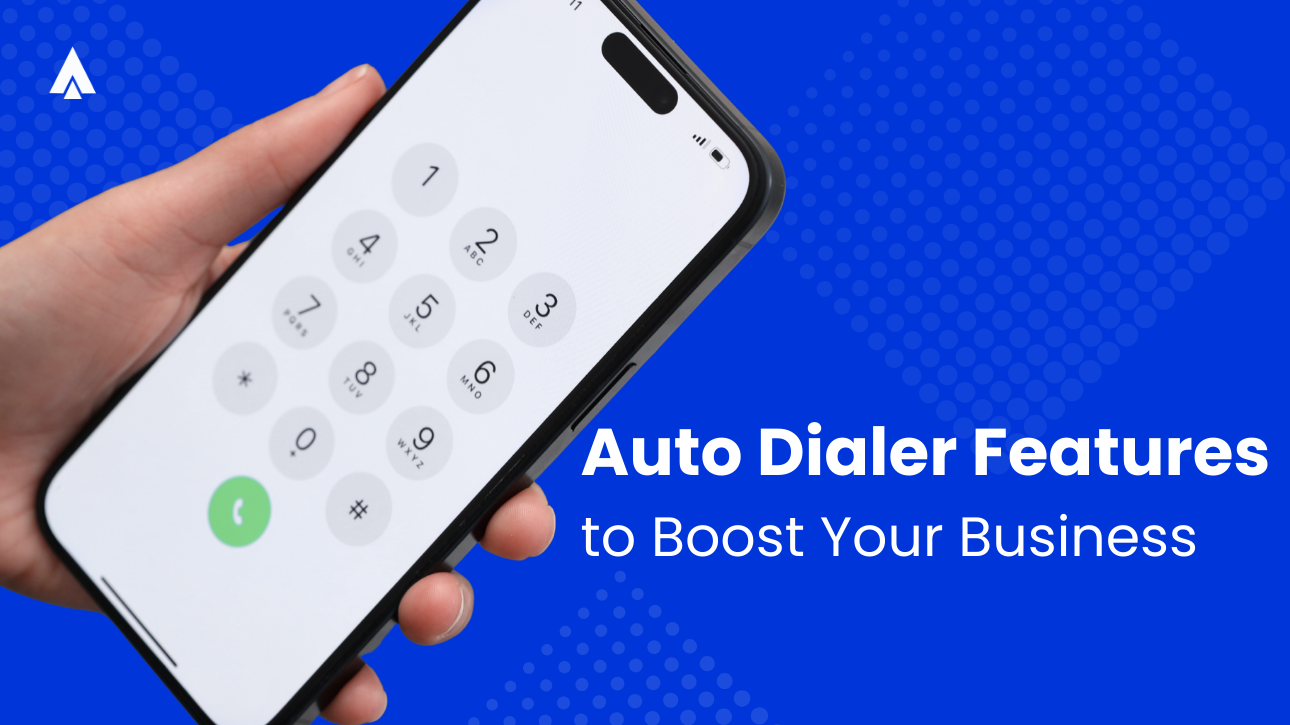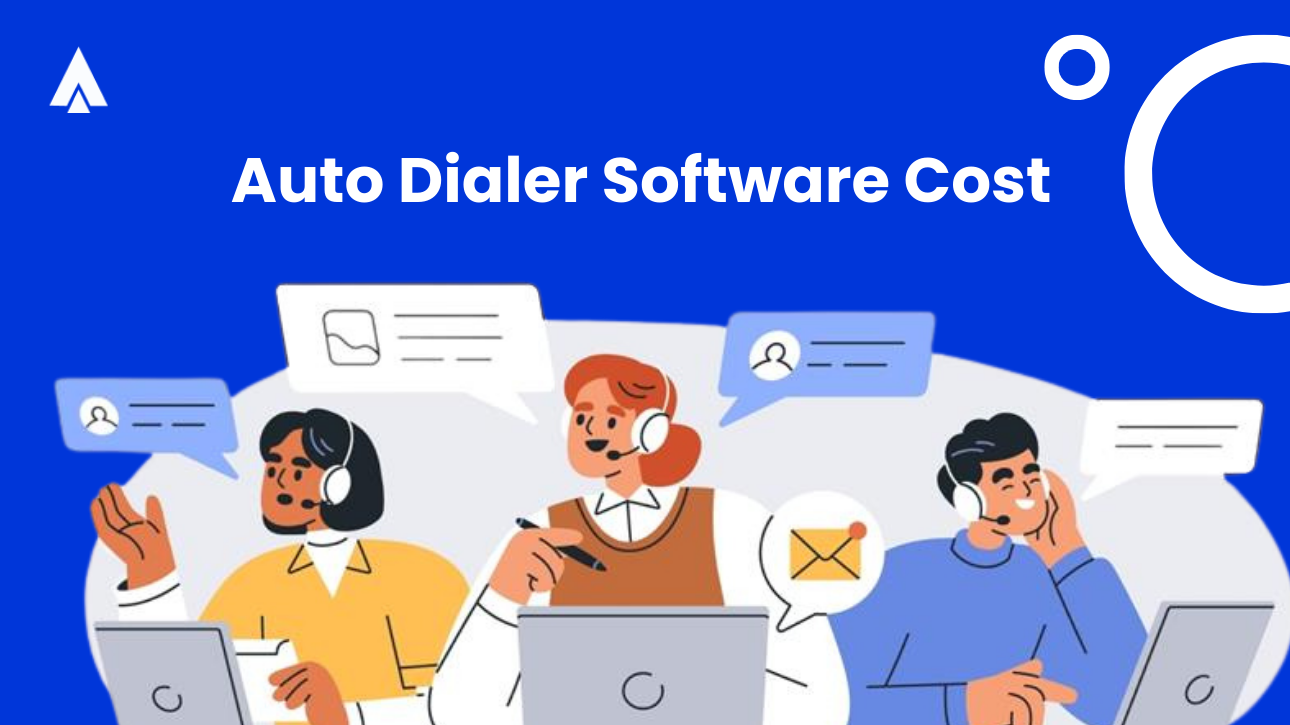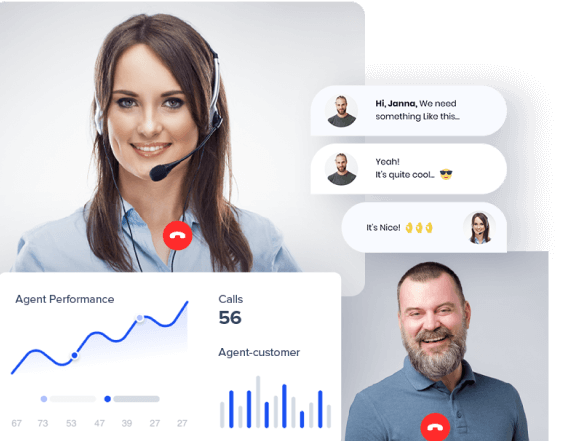Call center agents using manual dialing spend just 10-15 minutes of every hour actually talking to prospects. The rest is consumed by dialing, waiting for connections, and encountering busy signals or voicemails. This kind of inefficiency quietly eats into profits. Sadly, most businesses don’t even realize it until they take a hard look at the numbers behind agent productivity.
The global auto dialer software market projects explosive growth from $506.6 million in 2024 to $1.22 billion by 2034. Forward-thinking leaders know it’s no longer a question of if they need automated dialing, it’s a must. The real question is: which type will give them the highest ROI?
Let’s understand the types of auto dialers in detail to find out which type might be the best suited for your company.
What is an Auto Dialer?
An auto dialer automates dialing phone numbers from a predetermined customer list. This eliminates the manual effort agents traditionally spend inputting numbers and waiting for connections. These systems intelligently detect busy signals, voicemails, disconnected numbers, and answering machines, routing only live connections to available agents.
Modern auto dialers integrate seamlessly with Customer Relationship Management (CRM) systems and Enterprise Resource Planning (ERP) platforms. This helps provide real-time analytics, monitor call quality, and manage campaigns seamlessly.
How Does an Auto Dialer Work?
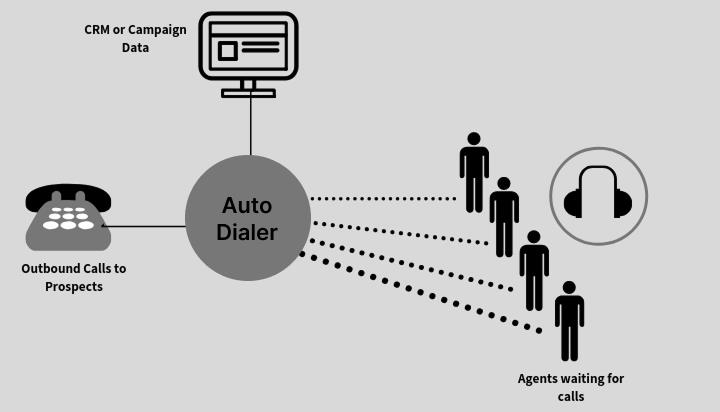
An auto dialer works by automatically calling numbers from a preloaded contact list, eliminating the need for agents to dial manually. The system pulls these numbers from a CRM or uploaded file and dials them in bulk using a selected dialing mode. As it dials, the software intelligently skips busy lines, unanswered calls, and numbers on Do-Not-Call (DNC) lists.
When a call is answered by a human, it’s instantly routed to an available agent, who sees a pop-up with relevant customer details. If the call goes to voicemail or a machine, the system either logs the attempt or plays a pre-recorded message.
After the call, the agent records the outcome, and the dialer immediately queues up the next contact, keeping workflows smooth and uninterrupted. Most advanced dialers also integrate with CRMs, filter calls by time zone, and offer analytics dashboards for real-time performance insights.
What are the Types of Auto Dialers?
Now that you understand what an auto dialer is, let’s look at its types:
1. Ratio Dialer
Ratio dialers are all about precision. Instead of using complex algorithms, they follow a simple formula—set a fixed number of calls per available agent. That could mean a 1:1 ratio for low-risk campaigns or up to 3:1 or 4:1 for high-volume dialing, depending on your strategy.
With ratio dialers, you’re in the driver’s seat. You decide how many calls go out per agent. This gives you tighter control over pacing and prevents your agents from getting overwhelmed. It’s perfect when you need predictability and compliance without sacrificing performance.
Here’s what you can control:
- Call-to-agent ratios: Choose from 1:1 to 4:1 based on your campaign’s needs
- Pacing limits: Keep systems stable with built-in caps
- Live adjustments: Change ratios in real time depending on staffing
- Compliance settings: Stick to dialing limits to avoid regulatory issues
Ratio dialers shine in industries where compliance isn’t optional. Think debt collection or financial services, anywhere the cost of non-compliance is high. Because they follow set ratios, these dialers help you forecast performance, avoid abandon rate penalties, and maintain consistency across campaigns.
2. Preview Dialer
The preview dialer software deliver contact records to outbound agents individually and automatically. But they allow the agent to review the contact details before calling a customer or prospect.
The on-time access to customer information makes it easier for the agents to personalize customer interactions and keep customers engaged. Also, the preview dialers dial telephone numbers automatically based on specific outbound marketing campaign setting.
The agents even have the option to skip specific telephone numbers on the list. Many call centers leverage preview dialers to deal with complex sales. As the agents can access the updated customer information, it becomes easier for them to conduct the research required to engage the leads and close complex sales deals.
However, the call centers cannot use preview dialers to make agents initiate more outbound calls.
3. Progressive Dialer
The progressive dialer system dial the next number on the contact list automatically and immediately after the agent wraps up a call. They initiate outbound calls as soon as the agent is available to handle the next call.
The modern call centers use progressive dialers to reduce wait time between calls. The progressive dialers even make agents more productive and enable them to handle more outgoing calls in a short amount of time.
The progressive dialers further make agents respond to only live calls. The agents even have the option to review customer information as the progressive dialer keeps dialing telephone numbers sequentially. Many call centers these days use progressive dialers to make agents handle outbound calls which are very similar in nature efficiently.
For more details, read this article “Predictive vs Progressive Dialers”
4. Predictive Dialer
Unlike preview and progressive dialers, predictive dialers use dialing algorithm to decide when an agent will be available to handle the next outgoing call. They even dial telephone numbers automatically and sequentially based on the prediction.
Also, they have the capability to detect busy signals, answering machines, voicemails, and disconnected calls. The call centers these days leverage predictive dialers to improve agent productivity and streamline outbound campaign management.
The cloud-hosted predictive dialers can be integrated seamlessly with ERP and CRM systems. They even help managers to assess call quality by monitoring live calls. But the call centers cannot leverage predictive dialers fully without deploying adequate outbound agents.
If no agent is available to handle the answered call, the call abandonment rate will increase significantly. At present, predictive dialers are being used widely by outbound call centers.
5. Power Dialer
Unlike predictive dialers, power dialer or rapid dialers do not predict when an agent will be available to handle the next outbound call. They dial the next telephone number on the list automatically and instantly after the agent wraps up the previous call.
These automated dialers have the capability to detect busy, disconnected, and unattended numbers. When the power dialer detects a live call, it connects the customer or lead to a live agent automatically and instantly.
But power dialers do not transfer or route the live calls to outbound calls. They require the agent to be live and available to handle the answered calls. The feature makes it easier for small businesses and start-ups to run outbound marketing campaigns without deploying additional agents.
Many call centers these days leverage power dialers to work with remote agents. But the call centers cannot use power dialers to handle high volume calls.
5 Benefits of Using an Auto Dialer
Auto dialers have become a cornerstone of efficient business communication. Automating the key parts of the calling process helps contact centers operate faster, smarter, and with greater consistency.
Let’s dive into five impactful ways auto dialers can transform your customer service operations:
1. Boost Agent Productivity
One of the biggest advantages of using an auto dialer is its ability to drastically cut down on non-productive time. Predictive dialers, for example, anticipate when an agent will become available and automatically place the next call. This way, the agent moves from one live conversation to the next with minimal delay.
Auto dialers also remove the need for manual number entry. Instead, they automatically dial from pre-loaded lists. They speed up the process and minimize the risk of misdials. And when the list is nearly exhausted, the system notifies the supervisor, making it easy to plan the next steps.
2. Improve Lead Conversion Rates
Auto dialers can also be highly effective tools for lead nurturing and conversion. In particular, preview dialers give agents access to detailed lead profiles before initiating a call. This includes past interactions, purchase history, preferences, and more.
Having this information readily available empowers agents to personalize their conversations and prioritize the most promising prospects. Rather than delivering generic sales pitches, agents can tailor each call based on the customer’s specific needs or interests. This leads to higher engagement and better conversion outcomes.
3. Enhance Operational Efficiency
Manually dialing numbers comes with a lot of inefficiencies like busy signals, disconnected numbers, voicemails, and call drops. Auto dialers eliminate these issues by detecting unproductive numbers and filtering them out. This ensures that agents spend more time talking to real people, not machines or empty lines.
Some dialers even use AI to optimize connect times and prioritize calls based on likelihood of success. The result? Better agent utilization, faster response times, and an overall smoother workflow for the entire team.
4. Simplify Campaign Management
Running multiple outbound campaigns at once can be a challenge, but modern auto dialers are built to handle this complexity. With intelligent dashboards, supervisors can easily set up, monitor, and adjust multiple campaigns simultaneously.
These systems provide real-time performance reports, which can be filtered by team, region, time zone, or CRM integration. Managers can analyze call volumes, contact rates, conversion trends, and more. All without switching platforms. This level of visibility helps teams respond quickly to underperforming campaigns and refine their strategies in real time.
5. Deliver Better Customer Experiences
Customer experience is at the heart of every successful support or sales interaction, and auto dialers help elevate it. Features like local presence dialing automatically display local area codes on outbound calls, increasing the chances that the recipient will answer.
Recommended Read: Benefits of an auto dialer
Compliance & Legal Considerations of Auto Dialers
When using auto dialers, compliance with telemarketing and privacy regulations is critical. Laws like the Telephone Consumer Protection Act (TCPA) in the U.S. restrict how and when automated calls can be made. Especially to the numbers on Do-Not-Call (DNC) registries.
Time-of-day restrictions also apply in many regions, meaning calls must be made only during legally permitted hours. In some industries, call recordings require prior consent as well.
Before opting for a solution provider, ensure they have DNC filtering, call time controls, consent management, and audit trails. It’s not just about avoiding fines, compliance also builds customer trust and protects your brand reputation.
What Are the Use Cases for Auto Dialers?
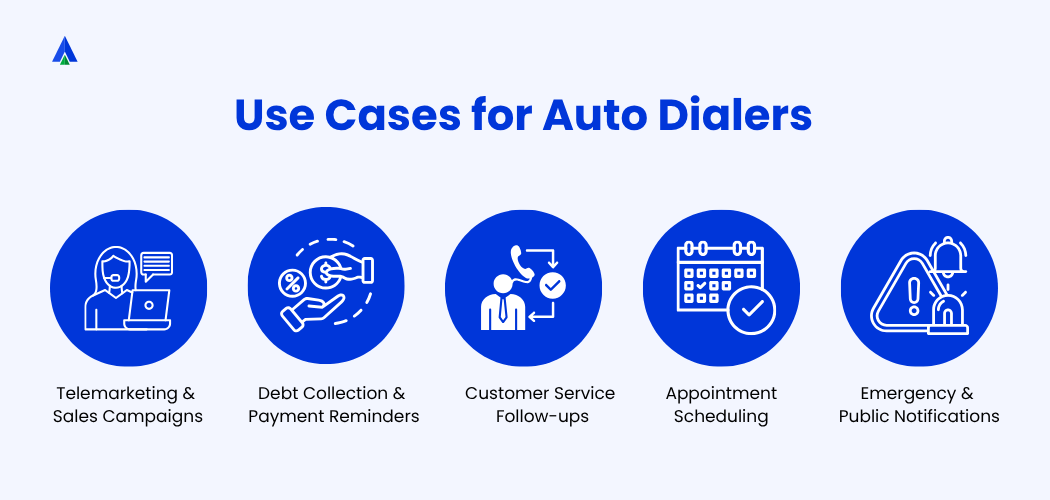
Businesses across industries can use auto dialers to streamline their calling workflows. Here are six popular use cases:
1. Telemarketing and Sales Campaigns
Auto dialers help outbound sales teams reach more prospects in less time by automating call placement. They also filter out unanswered calls or voicemails to keep agents focused on live conversations. Predictive and power dialers are often used to maximize agent talk time. This helps accelerate lead conversion by minimizing delays between calls.
2. Debt Collection and Payment Reminders
You can use auto dialers to remind customers about upcoming payments or follow up on missed dues. They’re also helpful for initiating calls to discuss repayment plans quickly.
Ratio and preview dialers work best in these scenarios. They give you greater control over compliance and let your agents prepare for sensitive conversations.
3. Customer Service Follow-ups
Auto dialers help you stay in touch with customers after a support ticket is closed or a service is delivered. You can also use them to collect feedback or confirm issue resolution. This proactive approach boosts customer satisfaction. It also helps you build stronger, lasting relationships.
4. Appointment Scheduling and Reminders
If you run a service-based business, auto dialers can help you confirm bookings and send timely reminders. You can even reschedule missed appointments with ease. This reduces no-shows and scheduling gaps. It also keeps your operations running smoothly throughout the day.
5. Emergency and Public Notifications
Government organizations can rely on auto dialers to broadcast urgent alerts, like weather warnings, outages, or safety notices to large groups quickly. This ensures timely communication during emergencies. It also helps reduce pressure on the support staff when it matters most.
Why Go for Hosted Auto Dialers
Switching to cloud-hosted auto dialers is a whole new way to run your call center smarter. You don’t need to invest in heavy hardware or wait weeks to get started. Cloud solutions are quick to deploy, easy to scale, and flexible enough to keep up with modern business needs.
Going hosted delivers real economic value too:
- Lower upfront costs: No need for expensive on-premise hardware
- Scales as you grow: Adjust capacity instantly, based on campaign needs
- Always up to date: New features roll out automatically—no IT help needed
- Work from anywhere: Easily support remote and distributed teams
Other than that, today’s cloud auto dialers come with a host of smart features designed to streamline operations:
- Live dashboards & reports to track performance in real time
- CRM integrations to keep all your data connected
- Built-in compliance tools to help you stay on the right side of regulations
- Multi-channel capabilities so you can coordinate across voice, SMS, email, and more
By going hosted, you free up your team to focus on what really matters—delivering great customer experiences.
For more details, you can contact “call center software“
Choosing the Right Auto Dialer for Your Business
There’s no one-size-fits-all auto dialer. The right choice depends on your goals, team, and industry regulations. Many companies use more than one type to handle different campaigns.
Here’s how to break it down:
- Speed vs. quality: Predictive dialers work great for high-volume sales. For deeper conversations, try preview or progressive modes.
- Regulation-heavy industries: Use power or progressive dialers to minimize dropped calls and stay compliant.
- Agent experience: Preview dialers give agents time to prep for complex conversations. Predictive works best with skilled, fast-paced teams.
- Tech resources: If your IT team is lean, cloud-hosted options save time and effort.
Tip: A simple decision tree can help map your needs to the right dialer.
Calculating the Real ROI
Want to see if it’s worth the investment? Here’s how to measure your dialer’s impact:
- Higher productivity: More talk time and more daily connections
- Lower costs: Less manual work, no hardware expenses
- Increased revenue: Better conversions mean more sales
- Compliance savings: Fewer fines and legal risks
Best Practices for Effective Auto Dialing
Rolling out a new dialer isn’t just about the tech. Success depends on how well your team adapts. Start with strong onboarding and track the right performance metrics.
Key metrics to monitor:
- Agent talk time (aim for 85–90% productive use)
- Contact rate (how many calls actually connect)
- Conversions per campaign
- Customer satisfaction (automation should never mean bad service)
Train your agents on:
- How to use the system
- CRM and workflow integration
- Compliance do’s and don’ts
- Interpreting performance metrics
Future-Proofing Your Investment
Auto dialers are evolving fast. Choose a platform that can grow with you and adapt to new technologies.
Watch out for these trends:
- AI-powered optimization: Predict best times to call and prioritize leads
- Voice analytics: Real-time coaching based on call data
- Omnichannel support: Combine voice, chat, email, and SMS in one place
- Smarter compliance tools: Automated consent prompts and call logging
Conclusion
Choosing the right auto dialer can dramatically transform how your business connects with customers—boosting productivity, improving compliance, and increasing revenue. Whether you need precision from ratio dialers, the control of preview modes, or the scale of predictive technology, Acefone’s hosted auto dialer solutions offer the flexibility and intelligence to match your goals.
With seamless CRM integration, real-time reporting, and powerful cloud infrastructure, Acefone helps you drive smarter campaigns, empower your agents, and deliver exceptional customer experiences—at scale.
Auto Dialer FAQs
Yes, but compliance depends on how you use them. In countries like the U.S., laws like the TCPA mandate prior consent for calling mobile numbers using auto dialers. Good software offers built-in compliance features such as call throttling, opt-out management, and monitoring to help organizations follow applicable regulations.
The number of calls depends on your dialer type and available agents. Predictive dialers can place hundreds of calls per hour by dialing multiple numbers at once. However, actual connections depend on pickup rates, agent availability, and list quality. High-volume systems can manage thousands of simultaneous dials with ease.
Essential features include CRM integration, call recording, live dashboards, call routing, and campaign management. You’ll also want tools for compliance, analytics, and agent monitoring. Look for systems that are scalable, user-friendly, and offer strong support. If your team handles sensitive data, data security should also be a top priority.
Auto dialers reduce manual tasks like dialing numbers or waiting through unanswered calls. By connecting agents only to live calls, they spend more time talking to customers and less time on admin. This boosts daily call volumes, shortens wait times, and helps agents focus on delivering better customer conversations.
Absolutely. Auto dialers help small businesses reach more prospects in less time without hiring large teams. With features like call scheduling, lead prioritization, and CRM integration, even lean teams can manage large call volumes efficiently. It’s a cost-effective way to boost outreach and scale sales or support efforts.
